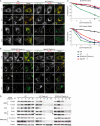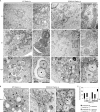Parkin mediates proteasome-dependent protein degradation and rupture of the outer mitochondrial membrane
- PMID: 21454557
- PMCID: PMC3103342
- DOI: 10.1074/jbc.M110.209338
Parkin mediates proteasome-dependent protein degradation and rupture of the outer mitochondrial membrane
Abstract
Upon mitochondrial depolarization, Parkin, a Parkinson disease-related E3 ubiquitin ligase, translocates from the cytosol to mitochondria and promotes their degradation by mitophagy, a selective type of autophagy. Here, we report that in addition to mitophagy, Parkin mediates proteasome-dependent degradation of outer membrane proteins such as Tom20, Tom40, Tom70, and Omp25 of depolarized mitochondria. By contrast, degradation of the inner membrane and matrix proteins largely depends on mitophagy. Furthermore, Parkin induces rupture of the outer membrane of depolarized mitochondria, which also depends on proteasomal activity. Upon induction of mitochondrial depolarization, proteasomes are recruited to mitochondria in the perinuclear region. Neither proteasome-dependent degradation of outer membrane proteins nor outer membrane rupture is required for mitophagy. These results suggest that Parkin regulates degradation of outer and inner mitochondrial membrane proteins differently through proteasome- and mitophagy-dependent pathways.
Figures






Similar articles
-
Proteasome and p97 mediate mitophagy and degradation of mitofusins induced by Parkin.J Cell Biol. 2010 Dec 27;191(7):1367-80. doi: 10.1083/jcb.201007013. Epub 2010 Dec 20. J Cell Biol. 2010. PMID: 21173115 Free PMC article.
-
Broad activation of the ubiquitin-proteasome system by Parkin is critical for mitophagy.Hum Mol Genet. 2011 May 1;20(9):1726-37. doi: 10.1093/hmg/ddr048. Epub 2011 Feb 4. Hum Mol Genet. 2011. PMID: 21296869 Free PMC article.
-
N-degron-mediated degradation and regulation of mitochondrial PINK1 kinase.Curr Genet. 2020 Aug;66(4):693-701. doi: 10.1007/s00294-020-01062-2. Epub 2020 Mar 10. Curr Genet. 2020. PMID: 32157382 Review.
-
Loss of MIEF1/MiD51 confers susceptibility to BAX-mediated cell death and PINK1-PRKN-dependent mitophagy.Autophagy. 2019 Dec;15(12):2107-2125. doi: 10.1080/15548627.2019.1596494. Epub 2019 Mar 28. Autophagy. 2019. PMID: 30894073 Free PMC article.
-
Regulating mitochondrial outer membrane proteins by ubiquitination and proteasomal degradation.Curr Opin Cell Biol. 2011 Aug;23(4):476-82. doi: 10.1016/j.ceb.2011.05.007. Epub 2011 Jun 24. Curr Opin Cell Biol. 2011. PMID: 21705204 Free PMC article. Review.
Cited by
-
The Role of Ubiquitination in Osteosarcoma Development and Therapies.Biomolecules. 2024 Jul 3;14(7):791. doi: 10.3390/biom14070791. Biomolecules. 2024. PMID: 39062505 Free PMC article. Review.
-
Mitochondrial inorganic polyphosphate is required to maintain proteostasis within the organelle.Front Cell Dev Biol. 2024 Jul 10;12:1423208. doi: 10.3389/fcell.2024.1423208. eCollection 2024. Front Cell Dev Biol. 2024. PMID: 39050895 Free PMC article.
-
Liver Cell Mitophagy in Metabolic Dysfunction-Associated Steatotic Liver Disease and Liver Fibrosis.Antioxidants (Basel). 2024 Jun 15;13(6):729. doi: 10.3390/antiox13060729. Antioxidants (Basel). 2024. PMID: 38929168 Free PMC article. Review.
-
SPRED2 Is a Novel Regulator of Autophagy in Hepatocellular Carcinoma Cells and Normal Hepatocytes.Int J Mol Sci. 2024 Jun 6;25(11):6269. doi: 10.3390/ijms25116269. Int J Mol Sci. 2024. PMID: 38892460 Free PMC article.
-
Burkholderia pseudomallei BipD modulates host mitophagy to evade killing.Nat Commun. 2024 Jun 4;15(1):4740. doi: 10.1038/s41467-024-48824-x. Nat Commun. 2024. PMID: 38834545 Free PMC article.
References
-
- Dickson D. W., Braak H., Duda J. E., Duyckaerts C., Gasser T., Halliday G. M., Hardy J., Leverenz J. B., Del Tredici K., Wszolek Z. K., Litvan I. (2009) Lancet Neurol. 8, 1150–1157 - PubMed
-
- Obeso J. A., Rodriguez-Oroz M. C., Goetz C. G., Marin C., Kordower J. H., Rodriguez M., Hirsch E. C., Farrer M., Schapira A. H., Halliday G. (2010) Nat. Med. 16, 653–661 - PubMed
-
- Abou-Sleiman P. M., Muqit M. M., Wood N. W. (2006) Nat. Rev. Neurosci. 7, 207–219 - PubMed
-
- Zhu J., Chu C. T. (2010) J. Alzheimers Dis. 20, Suppl. 2, S325–S334 - PubMed
-
- Kitada T., Asakawa S., Hattori N., Matsumine H., Yamamura Y., Minoshima S., Yokochi M., Mizuno Y., Shimizu N. (1998) Nature 392, 605–608 - PubMed
Publication types
MeSH terms
Substances
LinkOut - more resources
Full Text Sources
Other Literature Sources
Research Materials

